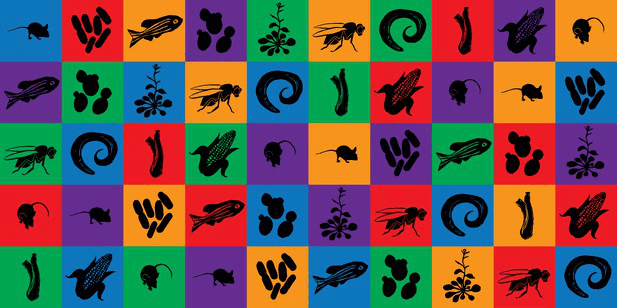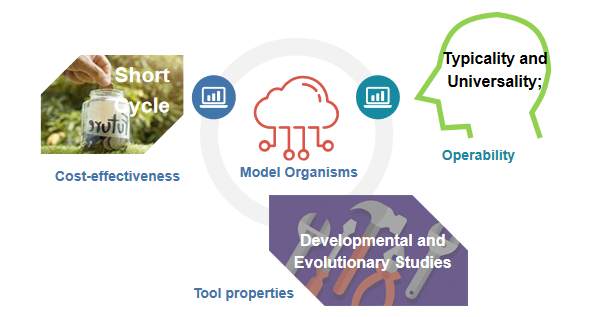Creative Bioarray provides in situ visualization solutions and probe customization services for a variety of model organisms. Our FISH technology platform is designed to establish a comprehensive analysis sample library and expand our business scope. Our goal is to help researchers perform rapid, batch-wise analysis for high-quality gene expression and localization analysis. Our technology platform has a high-quality service team and a complete equipment platform to provide researchers with high-quality probe customization and image services.
Model Organisms in Research
Model organisms have become irreplaceable tools for basic biology and clinical research. By developing model organisms to study biological problems, many basic principles of biology have been discovered. The basic definition of a model organism is a species used to study a specific biological process. They have genetic characteristics similar to those of humans and are often used in research fields such as genetics, developmental biology, and neuroscience. Model organisms are often chosen because they are easy to maintain and reproduce in a laboratory setting, have short generational cycles, or are able to generate mutants to study certain traits or diseases. Model organisms provide valuable insights into biological systems at the cellular, tissue, organ and system levels. There are several types of model organisms, which vary in complexity and purpose. Small, simple organisms, such as yeast, are commonly used to study genetic mutations in human cancers, while Drosophila, zebrafish, and others are ideal for studies of genetics and disease development. Currently, mouse models are widely used in biomedical research to study disease mechanisms and develop new drugs.
 Fig 1. Some common model organisms. (Jane Alfred, et al. 2015)
Fig 1. Some common model organisms. (Jane Alfred, et al. 2015)
Visual Analysis for Model Organisms
A handful of model organisms have been defined by the scientific community, including some mammals, fish (mostly zebrafish), birds (mostly chickens), frogs, flies, and nematodes. In the case of mice, rodents are by far the most commonly used laboratory animals in biomedical research. Mice share many biological similarities with humans and can be genetically manipulated to express mutations associated with human disease. In addition, model organisms reproduce relatively quickly and have a short lifespan, which allows scientists to study progressive diseases, including aging. Our FISH service can visualize gene expression or chromosomal structural variation in these processes, helping researchers test hypotheses or gain additional evidence.
Available Model Organisms
- Model plants that our platform can analyze include Arabidopsis thaliana, Rice(Oryza sativa), Soybean(Glycine max)Corn(Zea mays);
- Model animals that can be analyzed by our platform include, but are not limited to, the following species: Chicken, Pig, Dog, Rabbit, Cat(Felis catus), Rat(Rattus norvegicus), Rhesus monkey(Macaca mulatta), Sheep(Ovis aries), Cynomolgus(Macaca fascicularis), Bovine(Bos taurus), Fly(Drosophila melanogaster), Zebrafish(Danio rerio), Frog(Xenopus laevis)
- Other uncommon model organisms that can be analyzed include but are not limited to the following species (custom probes):
Cricetulus griseus, Microtus ochrogaster, Meriones unguiculatus;
Callithrix jacchus, Tribolium castaneum, Asparagus officinalis, Coturnix japonica;
Oreochromis niloticus, Oncorhynchus mykiss, Gasterosteus aculeatus, Hynobius chinensis, Notophthalmus viridescens, Oplegnathus fasciatus;
Taeniopygia guttata, Ciona intestinalis, Haemaphysalis longicornis, Anopheles gambiae;
Most of the above species have commercial probes, of course, we also provide design and customization services for probes outside the catalogue. Welcome to consult our experts.
 Fig 2. Availability of FISH assays in model organisms.
Fig 2. Availability of FISH assays in model organisms.
If you are interested in our service, please contact us for cooperation. We look forward to cooperating with you in the near future.
References
- Alfred, Jane, and Ian T. Baldwin. "The natural history of model organisms: new opportunities at the wild frontier." Elife 4 (2015): e06956.
- Peter, Angela K., Claudia Crocini, and Leslie A. Leinwand. "Expanding our scientific horizons: utilization of unique model organisms in biological research." The EMBO Journal 36.16 (2017): 2311-2314.


 Fig 1. Some common model organisms. (Jane Alfred, et al. 2015)
Fig 1. Some common model organisms. (Jane Alfred, et al. 2015) Fig 2. Availability of FISH assays in model organisms.
Fig 2. Availability of FISH assays in model organisms.


